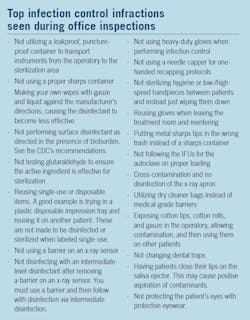Infection control review: More viewpoints to consider
Editor’s Note: This is part two of a series. Read part one here.
The exploration and journey of infection control as seen through different perspectives is eye-opening. To ensure that you, as the person performing infection control procedures, have all recommendations satisfied, here are a couple more viewpoints to keep in mind. This series is to help you understand the various aspects of infection control. Some of the points of view may help you pivot your procedures and align them to the best practices from all viewpoints, as they are all equally important. A critical perception is that of the manufacturer of the dental equipment you are using day in, day out.
The equipment: A silent but critical viewpoint
Equipment has its own needs that are often muted or overlooked. At times, we may carry out infection control on equipment based on what we think is correct rather than what is recommended by the equipment manufacturer as safe to use on the equipment. Every manufacturer performs material compatibility tests on their equipment and then publishes their recommendations in their instructions for use (IFU). This is true for almost all pieces of equipment within your office.
Infection control review: Common oversights from three perspectives
Staying compliant and committed to infection control
When it comes to cleaning, disinfecting, and sterilizing, the directives are very clear. The key for success is to go through your office and take time to get all your IFUs together. Sometimes your dealer representative will have them for you in a PDF report. Once you have fully assessed your equipment needs for cleaning, disinfecting, and sterilizing, you will then be able to match them to your office’s protocol to ensure you are in line. You can typically have only one product for cleaning and one to two products for disinfecting to keep Centers for Disease Control and Prevention (CDC)-level sterilization protocols in place.
Extraoral equipment: A good place to start with your equipment would be with the biggest pieces that are extraoral in use—e.g., dental chairs and x-ray equipment. Belmont Dental, one of the leading dental chair manufacturers, nicely lays out their recommendations so their quality products have a long life. Their IFUs specifically recommend cleaning chairs with mild soap and warm water daily, regardless of the chemical disinfectant used. They also mention use of a barrier should be the first choice in protecting dental equipment.1 The CDC states that if a medical-grade barrier is used and not compromised, surface disinfection does not have to be performed. That’s why most dental equipment manufacturers recommend the use of barriers.2
Above: Top infection control infractions seen during office inspections
Intraoral equipment: Ensure you are compliant with the IFUs for any pieces of equipment that are used intraorally, such as curing lights, x-ray sensors, and intraoral scanners. The CDC clearly recommends infection control for these items due to the intraoral aspect of their use.2 Their recommendation is to use a barrier and then an intermediate-level disinfectant. Ideally, you should use a disinfectant that is fungicidal, tuberculocidal, bactericidal, and virucidal.
When looking through the IFUs, if you discover that cleaning dental chairs daily or using a combination of a medical-grade barrier and intermediate-level disinfectant on curing lights are something your office has not been doing, you have an opportunity to level up your infection control protocols to benefit your equipment, your patients, and your office budget. Make sure the chain of infection control is not broken. If you can ensure that platinum-level infection control is occurring and lengthening the life of your equipment, you’ll alleviate anxiety and make your day easier. Another benefit is that this protocol will lessen the burden on the person in charge of ordering supplies for the office.
The dental product supply purchaser
Infection control for office purchasers is challenging. They must constantly assess how to save the office money while still maintaining a high level of infection control. One gap commonly seen is in product value. It would be beneficial to spend more on the right infection control products than to save money on the wrong products, which could create a breach in the infection control chain. Not only would a breach compromise patient care, but it would also compromise staff safety, the practice’s reputation, and the doctor’s safety. Using products and procedures that go against the state’s infection control rules and regulations could set up the practice for hours of continuing education requirements, fines, and multiple inspections.
It would be ideal to partner with an infection control coordinator to ensure that the best products and equipment are purchased for everyone. The office supply manager can team up with the equipment dealer and manufacturers’ reps to inquire about any promotions they have available. Some manufacturers offer heavy discounts if the purchaser buys in bulk. The office supply purchaser’s number one action that compromises infection control is buying products from an unauthorized dealer. These infection control products could be expired and relabeled, but you would never know. Risking the health of others is not worth the small amount of money the office saves.
The business owner’s point of view
Social media: Social media offers a new portal for offices to showcase their infection control practices to their patients and prospective patients, which is particularly important as more COVID-19 variants emerge. People who used to mock airline disinfection practices are now asking if they have been done prior to boarding. The eyes of the public are attuned to their post-COVID environment and assume everything should be cleaned and disinfected to a platinum level. Social media has become an easy place to position your practice on the infection control podium of excellence. Patients not only want the best care, but they also want to feel safe and comfortable while getting it. By showcasing your office’s infection control protocols and highlighting specialized equipment for infection control, patients can tour your office virtually to get a feel for its standards before they even step foot inside. This approach, along with the instant referrals of others, can either attract or repel patients depending on how your office is perceived on social media. Word-of-mouth can be one of the best (or worst) methods of referral.
The cost: Everything comes down to cost. It’s important for your office to see a return on investment for infection control products. The cost of an infraction is far more damaging to the office’s budget, your patients’ health, and your practice’s reputation than the extra cost of using the best infection control products. The cost to protect your equipment is far greater in the long run than using inexpensive products that don’t meet manufacturers’ recommendations. Products can save you money by having quicker kill times and being easier to use and order. But infection control is not the place to skimp on dollars. Reach out to the manufacturers of your favorite dental products and see if they have local reps you can talk with. Manufacturers often run promotions that you can take advantage of, and dental product dealers also have flyers and ongoing promotions. Signing up for current email blasts with specials is well worth the time. If you buy products in bulk, your manufacturer or dealer rep may have promotions for bulk buys.
Conclusion
As you can see, infection control can be viewed from many different aspects, each one critical to the goal that everyone is striving for. Table 1 lists the top infractions found in infection control. If you would like a personal viewpoint for your office, reach out to your local infection control manufacturer’s rep for an office walk-through or lunch-and-learn. Their specialty in infection control will enable you to have the most up-to-date information and a second set of eyes on your practice. Remember, like all things in life, perspective is everything. Making small efforts to level-up your infection control game will create a win-win for everyone.
Editor's note: This article appeared in the October 2022 print edition of RDH magazine. Dental hygienists in North America are eligible for a complimentary print subscription. Sign up here.
References
- Belmont Dental. Accessed February 14, 2022. https://dental.takarabelmont.com/
- Centers for Disease Control and Prevention. Summary of Infection Prevention Practices in Dental Settings: Basic Expectations for Safe Care. Atlanta, GA: Centers for Disease Control and Prevention, US Dept of Health and Human Services; October 2016. https://www.cdc.gov/oralhealth/infectioncontrol/pdf/safe-care2.pdf
About the Author

Maryanne Ferree, BS, RDH, PHDHP
Maryanne Ferree, BS, RDH, PHDHP, is a registered dental hygienist with more than 35 years of experience. She has ventured into many facets of dental hygiene, including clinical care, public health, and education. She enjoys teaching the next generations of dental students at the University of Pittsburgh, School of Dental Medicine. Ferree has been excited to step into the role of key opinion leader and blogger to share her enthusiasm for all things infection control. She continues to advance her education by finishing the last year of her MPH and focusing on infectious disease and microbiology. She can be reached at [email protected].
Updated October 25, 2021

Nicole Giesey, MBA, MSTPE, BSDH, RDH
Nicole Giesey, MBA, MSPTE, BSDH, RDH, is dedicated to researching, writing, and helping people in general through her current platform. She began her career as a dental assistant and then progressed into dental hygiene, then branching into dental hygiene education. With the opportunity to get into dental product management knocking at her door, she leaped into the world of dental sales. She is now a dental product sales representative and can be reached at [email protected].
Updated September 9, 2021

